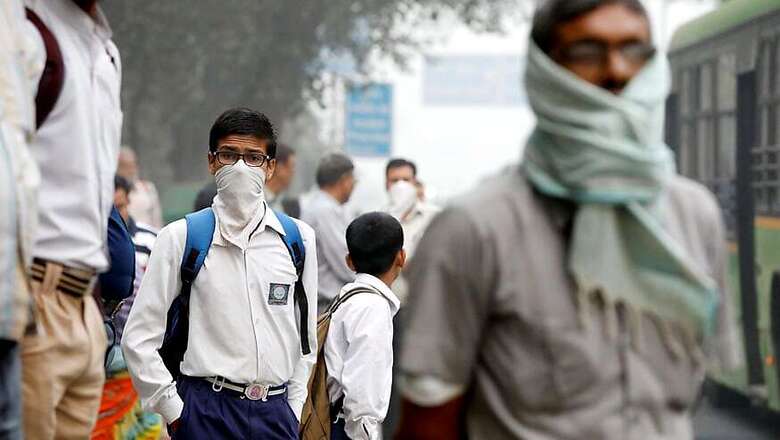
views
New Delhi: How much difference can a number make in how Delhi fights air pollution? A lot, according to Air Quality Index (AQI), the current standard determining a good day from an emergency.
The AQI directly affects the implementation of the Graded Response Action Plan (GRAP) and the measures to be taken when the smog hits. One number is all it takes to tip the response from ‘very poor’ to ‘severe’ to ‘emergency’ category.
The numbers right now, though, are devoid of human response and that, said one of the scientists involved in GRAP, is a dangerous way to make decisions.
“How much weight do we give one number in promulgating emergency measures?” asked Professor Mukesh Khare, from IIT-Delhi and a member of the Environment Pollution (Prevention and Control) Authority (EPCA) that drafted GRAP.
“I’m an EPCA member and I teach AQI to my students but I feel that one number is quite dangerous to take a decision on,” he said.
Both the AQI and the GRAP, according to Khare, need to evolve based on maths and science. “I may be okay in the current AQI but you may be more sensitive to the pollution. The numbers don’t take into account these perceptions,” said Khare.
The index needs to account for “public opinion and effect on the receptors”, as the receptors are human.
“Human response needs to be analysed along with the data,” he explained, “and maths has a methodology available in the fuzzy logic theory.”
Computer scientists, in the journal – Scientific American, define fuzzy logic as “a generalisation of standard logic, in which a concept can possess a degree of truth anywhere between 0.0 and 1.0. Standard logic applies only to concepts that are completely true (having a degree of truth 1.0) or completely false (having degree of truth 0.0). Fuzzy logic is supposed to be used for reasoning about inherently vague concepts, such as tallness”.
Varied human responses to rising air pollution are the vague concepts that need to be translated into data to make our air pollution standards more ‘realistic and reliable’ in making decisions, said Khare.
Currently, the AQI follows an empirical formula measuring the concentration of PM10, PM2.5, SOx and NOx. The pollutant with the maximum concentration among these four, sets the index. In the Delhi smog episode, the index was PM2.5.
The index then goes on to dictate GRAP, the year-old response plan that the EPCA came up with, when the Supreme Court on November 10, 2016, asked for a smog alert system.
In a review submitted to the court on Monday, the EPCA listed what needs to be done further to help GRAP. Majorly, it has asked for better weather forecasts, so that the agencies have an advance notice of smog. In 2016 and 2017, the EPCA only had a day’s notice, that too without information on the anti-cyclonic weather disturbance creating the smog.
The EPCA has asked for “a vastly strengthened system of health advisories for people to take preventive action” and the implementation of the longer term ‘Comprehensive Action Plan for Air Pollution Control for NCR’.
However, Khare pointed out that GRAP, itself, needed academic exercise to reorder its priorities. “I appreciate that we’ve started something,” he said, “but it is currently a generic plan.”
“There is no quantification of the responses listed according to category. How much of an effect did banning diesel generator sets have?” asked Khare as an example.
The IIT professor further asked, how, if the gensets were shut down on October 17, when GRAP put Delhi in the ‘very poor to severe’ category, the pollution only increased? “They (gensets) are a contributor but their closure is not affecting the (pollution) concentration.”
He called for a year-long study, evaluating each response, conducted in any institution with requisite facilities, based on an emission model. “We can then evaluate each and every response while creating scenarios. This will provide to be a decision-making tool and make GRAP more realistic,” said Khare.
The EPCA had told the court that, according to weather experts, the smog episode was “unprecedented”.
The report said, “Two air circulatory systems – one bringing pollutants from crop burning in Punjab and Haryana (according to one theory, also, dust from multi-day dust storm in Iraq, Kuwait and Saudi Arabia) and the other bringing moisture from the east, which collided over Delhi region. This formed a cloud of pollutants, trapped in moisture, which combined with near calm wind conditions at the ground-level, suffocating the region.” The EPCA is now working with the Ministry of Earth Science and IMD to see how forecast and predictions can be improved.
After the state of confusion that was 2016 — the EPCA report pointed out policy paralysis and lack of proper health advisories. While GRAP is certainly a comprehensive step forward, it still has miles to go.




















Comments
0 comment